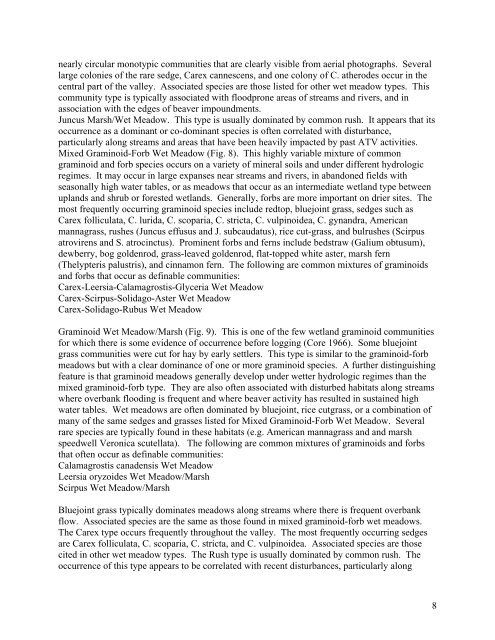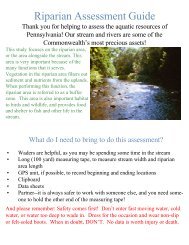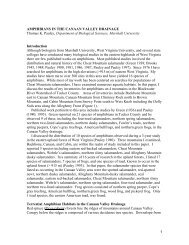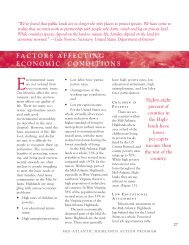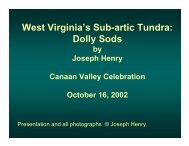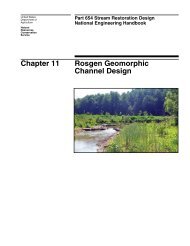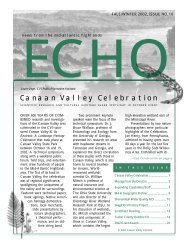rare plant communities in canaan valley, west virginia
rare plant communities in canaan valley, west virginia
rare plant communities in canaan valley, west virginia
Create successful ePaper yourself
Turn your PDF publications into a flip-book with our unique Google optimized e-Paper software.
nearly circular monotypic <strong>communities</strong> that are clearly visible from aerial photographs. Severallarge colonies of the <strong>rare</strong> sedge, Carex cannescens, and one colony of C. atherodes occur <strong>in</strong> thecentral part of the <strong>valley</strong>. Associated species are those listed for other wet meadow types. Thiscommunity type is typically associated with floodprone areas of streams and rivers, and <strong>in</strong>association with the edges of beaver impoundments.Juncus Marsh/Wet Meadow. This type is usually dom<strong>in</strong>ated by common rush. It appears that itsoccurrence as a dom<strong>in</strong>ant or co-dom<strong>in</strong>ant species is often correlated with disturbance,particularly along streams and areas that have been heavily impacted by past ATV activities.Mixed Gram<strong>in</strong>oid-Forb Wet Meadow (Fig. 8). This highly variable mixture of commongram<strong>in</strong>oid and forb species occurs on a variety of m<strong>in</strong>eral soils and under different hydrologicregimes. It may occur <strong>in</strong> large expanses near streams and rivers, <strong>in</strong> abandoned fields withseasonally high water tables, or as meadows that occur as an <strong>in</strong>termediate wetland type betweenuplands and shrub or forested wetlands. Generally, forbs are more important on drier sites. Themost frequently occurr<strong>in</strong>g gram<strong>in</strong>oid species <strong>in</strong>clude redtop, bluejo<strong>in</strong>t grass, sedges such asCarex folliculata, C. lurida, C. scoparia, C. stricta, C. vulp<strong>in</strong>oidea, C. gynandra, Americanmannagrass, rushes (Juncus effusus and J. subcaudatus), rice cut-grass, and bulrushes (Scirpusatrovirens and S. atroc<strong>in</strong>ctus). Prom<strong>in</strong>ent forbs and ferns <strong>in</strong>clude bedstraw (Galium obtusum),dewberry, bog goldenrod, grass-leaved goldenrod, flat-topped white aster, marsh fern(Thelypteris palustris), and c<strong>in</strong>namon fern. The follow<strong>in</strong>g are common mixtures of gram<strong>in</strong>oidsand forbs that occur as def<strong>in</strong>able <strong>communities</strong>:Carex-Leersia-Calamagrostis-Glyceria Wet MeadowCarex-Scirpus-Solidago-Aster Wet MeadowCarex-Solidago-Rubus Wet MeadowGram<strong>in</strong>oid Wet Meadow/Marsh (Fig. 9). This is one of the few wetland gram<strong>in</strong>oid <strong>communities</strong>for which there is some evidence of occurrence before logg<strong>in</strong>g (Core 1966). Some bluejo<strong>in</strong>tgrass <strong>communities</strong> were cut for hay by early settlers. This type is similar to the gram<strong>in</strong>oid-forbmeadows but with a clear dom<strong>in</strong>ance of one or more gram<strong>in</strong>oid species. A further dist<strong>in</strong>guish<strong>in</strong>gfeature is that gram<strong>in</strong>oid meadows generally develop under wetter hydrologic regimes than themixed gram<strong>in</strong>oid-forb type. They are also often associated with disturbed habitats along streamswhere overbank flood<strong>in</strong>g is frequent and where beaver activity has resulted <strong>in</strong> susta<strong>in</strong>ed highwater tables. Wet meadows are often dom<strong>in</strong>ated by bluejo<strong>in</strong>t, rice cutgrass, or a comb<strong>in</strong>ation ofmany of the same sedges and grasses listed for Mixed Gram<strong>in</strong>oid-Forb Wet Meadow. Several<strong>rare</strong> species are typically found <strong>in</strong> these habitats (e.g. American mannagrass and and marshspeedwell Veronica scutellata). The follow<strong>in</strong>g are common mixtures of gram<strong>in</strong>oids and forbsthat often occur as def<strong>in</strong>able <strong>communities</strong>:Calamagrostis canadensis Wet MeadowLeersia oryzoides Wet Meadow/MarshScirpus Wet Meadow/MarshBluejo<strong>in</strong>t grass typically dom<strong>in</strong>ates meadows along streams where there is frequent overbankflow. Associated species are the same as those found <strong>in</strong> mixed gram<strong>in</strong>oid-forb wet meadows.The Carex type occurs frequently throughout the <strong>valley</strong>. The most frequently occurr<strong>in</strong>g sedgesare Carex folliculata, C. scoparia, C. stricta, and C. vulp<strong>in</strong>oidea. Associated species are thosecited <strong>in</strong> other wet meadow types. The Rush type is usually dom<strong>in</strong>ated by common rush. Theoccurrence of this type appears to be correlated with recent disturbances, particularly along8


